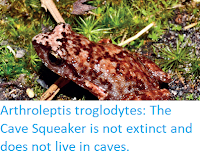Leopard Frogs, Rana spp., are found throughout North and Central America, where they are common in most damp environments. Despite their ubiquity, their taxonomy is not as well understood as might be expected, with new species being described regularly not just from the tropical regions of Central America, but from densely populated areas of North America (a new species was described from New York City in 2014).
In a paper published in the journal Systematics and Biodiversity on 4 January 2018, Ileana Luque-Montes of the Department of Wildlife Ecology and Conservation at the University of Florida, and the Department of Biology at the Indiana University of Pennsylvania, James Austin, also of the Department of Wildlife Ecology and Conservation at the University of Florida, Kayla Weinfurther, also of the Department of Biology at the Indiana University of Pennsylvania, Larry David Wilson of the Centro Zamorano de Biodiversidad at the Escuela Agrícola Panamericana Zamorano, and Erich Hofmann and Josiah Townsend, again of the Department of Biology at the Indiana University of Pennsylvania, describe a new species of Leopard Frog from the Chortís Highlands of central Honduras.
The majority of Leopard Frogs in Honduras have long been considered to belong to two species, Rana brownorum, which is found in river basins draining north into the Caribbean, and Rana forreri found in river basins draining south into the Pacific. There are also known to be morphologically distinct Leopard Frogs in the Chortís Highlands of central Honduras, that separate the two drainage zones. These have long been considered to be hybrids of the two lowland populations, found along the zone that separates the species. However, this does not fit well with our current understanding of species boundaries in Frogs and Amphibians, which suggests two lowland species are unlikely to hybridise to form produce a highland species, rather species are typically restricted to (often quite narrow) altitude bands, and topology often delineating the boundaries between populations of different species.
Luque-Montes et al. sampled the DNA of Leopard Frogs from across Honduras, and used these to establish that the Frogs of the Chortís Highlands are in fact a separate species. This species is named Rana lenca, in honour of the Lenca people of southwest Honduras. This species is slightly smaller than Rana brownorum and Rana forreri, with adult males reaching 46.6–64.3 mm, and females 43.7–76.3 mm, but have relatively larger heads than either of these species. They are greenish in colour, with well-defined dorsal spots and a paler underside.
Rana lenca, adult female from the Reserva Biologica Cerro Uyuca. Josiah Townsend in Luque-Montes et al. (2018).
See also...
Follow Sciency Thoughts on Facebook.







